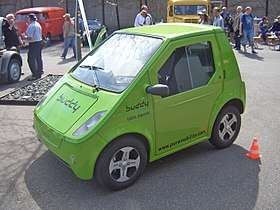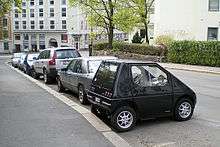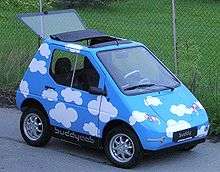Buddy (electric car)
Buddy is a Norwegian city electric car, produced by Buddy Electric in the early 2000s, formerly known as Pure Mobility and Elbil Norge AS, at Økern in Oslo. In 2007, the Buddy, and its predecessor, the Kewet, made up 20% of the electric cars in Norway.[1] Since its inception in 1991, combined sales of the Kewet and Buddy had totaled about 1,500 vehicles through October 2013,[2] of which, 1,087 were registered in Norway.[3]
| Buddy | |
|---|---|
 | |
| Overview | |
| Manufacturer | Buddy Electric (formerly known as Pure Mobility) |
| Body and chassis | |
| Class | heavy quadricycle |
| Body style | 2-door, 3-seater |
| Powertrain | |
| Electric motor | 72V Sepex 13 kW brushed DC motor |
| Dimensions | |
| Wheelbase | 1550 mm (61.0 in) |
| Length | 2440 mm (96 in) |
| Width | 1430 mm (56.3 in) |
| Height | 1440 mm (56.7 in) |
| Chronology | |
| Predecessor | Kewet |
History
Buddy is the sixth generation of the Kewet electric vehicle. Originally, the Kewet was developed in Hadsund, Denmark, and the first model was made in 1991. Production alternated between Hadsund, Denmark and Nordhausen, Germany. During the first five generations, over 1000 electric vehicles were produced. The vehicle was sold in eighteen countries. In 1998, all rights were acquired by ElBil Norge AS (which, at the time, was called Kollega Bil AS). For some years, ElBil Norge further developed the electric vehicle and in the autumn of 2005, a new model was presented that was first called Kewet Buddy Citi-Jet 6, but is now known simply as the Buddy.
In December 2008, the first 12 Buddy cars were sent from the Buddy factory in Økern by boat to Copenhagen.[4] In 2010, Pure Mobility (former "Elbil Norge") launched a brand new version of the Buddy. It was initially marketed as "MetroBuddy", but the "Metro" prefix was removed due to certain negative or confusing associations with the term.
Technology and production
Buddy is a simple, functional, electric city car with a range of 20 to 60 km (12 to 37 mi) depending on the season, topography and driving style. Maximum speed is 80 km/h (50 mph). Its length is 244 cm (96 in), which allows it in some jurisdictions to be legally parked sideways.
The Buddy consists of a strong, hot galvanized steel tube frame, complete with safety cage, but with no proper deformation zones. The body is made of thin fiberglass. Other metal parts are treated so that further rust treatment is unnecessary. The electric motor is a 72V Sepex 13 kW, a direct current motor with brushes. Well-tried technological solutions have been used to ensure maximal reliability. The car has no servo or aids regarding steering and braking. The response and "connection" to brakes and front wheels are vague and difficult to finesse. The vehicle also lacks safety equipment such as ABS, ESP, Airbags, etc.
The Buddy was produced with lead acid batteries, in which completely discharged batteries could be recharged in 6–8 hours. The batteries could be rapidly charged so that one hour's charging allows the vehicle to be driven about 10 km (6.2 mi). Charging requires an ordinary, grounded outlet with a minimum circuit of 10 A. The life expectancy for the batteries is expected to be between two and five years, or about 20 000 km, depending on driving and charging habits. A complete battery set costs from GB£2,800, excluding value added tax.
ElBil Norge has made a development fleet of Buddy vehicles equipped with various forms of Li-ion battery technology. When this technology is made available commercially, existing Buddy vehicles could potentially be upgradeable to the new technology.
The Buddy was EU approved by the Vehicle Certification Agency as an electric four-wheel motorcycle (heavy quadricycle). It can be used as an ordinary vehicle without restrictions as to the roads it can be driven on, and drivers require only an ordinary drivers license.
Two models of the Buddy were available, the ordinary variety, and BuddyCab which features a folding roof. In 2007, the production capacity at Økern in Oslo was 5–6 vehicles a week, with a theoretical production capacity of 500 vehicles annually. To meet international needs, ElBil Norge was working to establish new production localities. The Buddy was sold only in Norway while the company prepares for export.
As of late 2008, plans were under way for an additional factory in Portugal. The aim is to produce 5000 cars a year.[5]
Sales


The Buddy ranked 29th in terms of sales by automotive brands in Norway in 2006, ahead of Jaguar, Fiat, Smart and Porsche.[6] Most cars are black/dark/grey/silver, about 80% of Buddys are delivered in strong, bright colours[7] with many using bold decorative elements: flowers, hearts, clouds, and flames – and a multitude of colours. One Buddy was designed to match the owner's night table lamp.[8]
A total of 125 Buddies were sold in Norway during 2011 representing a market share of 6% of all electric vehicles sold in the country that year.[9] As of September 2013, a total of 1,087 units were registered in Norway, the leading market, consisting of 2 Kewet CITI VANs, 22 Kewet EL-JET (1-4)s, 50 Kewet CITI JET 5s, 379 Buddy M9 (2010-2013), and 634 Kewet Buddy Citi-Jet 6 (2005-2009).[3]
Operations and Ownership
Buddy was produced by Buddy Electric (formerly known as "Pure Mobility" and "ElBil Norge AS") which in 2003 changed its name from Kollega Bil AS. The company was originally established in 1992 and has been in the electric vehicle branch since that time. Managing director is Kjell Strøm. Elbil Norge AS is owned by the original founders Jan-Petter Skram and Viggo Vargum, in addition to external investors which include Hafslund Venture AS, Gezina AS (Th. Brøvig), members of the Selvaag family, Lychegaarden (Jens P. Heyerdahl) and Jan Chr G Sundt. The owners have expanded the company gradually. In 2005, an emission of NOK 12 million financed by the existing owners allowed for an expansion of the Økern factory. ElBil Norge had a profit in 2004 and 2005 and has a ratio of owner equity to debt of 90%.
Technical specifications [10]
- Mass without batteries: 400 kg (880 lb)
- Lead batteries weight: 395 kg (871 lb)
- Maximum allowed weight: 1,020 kg (2,250 lb)
- Seating capacity: 3 adults
- Length x Width x Height: 2440 x 1430 x 1440 mm
- Wheelbase: 155 cm
- Turning circle:7.0 m
- Motor: SepEx 72V DC
- Power: 13 kW
- Top speed: 80 to 90 km/h (50 to 56 mph)
- Acceleration: 0–50 km/h in 7 s
- Maximum hill-starting ability: 20%
- Suspension: Front – MacPherson struts. Rear – Independent telescopic suspension
- Wheels/Tyres standard: Alloy wheels 4Jx13 // 135(145)/80R13
- Brakes: Regenerative braking to enhance the driving range.
- Disc brakes on all wheels with double circuit braking system. Parking brake on the rear wheels
- Body: Fibreglass reinforced polyester
- Safety cabin: Welded tubular steel space frame, optional hot dip galvanised
- Batteries:
- Maintenance-free lead acid batteries, ca 10,5 kWh available.
- Under testing systems with lithium-ion battery technology, 10 or 14 kWh
- Charging time: 0-100% in 6–8 hours, 30-95% in 3 hours
- Range:
- Lead-acid batteries 50 to 100 km (31 to 62 mi), depending on road conditions, temperature and the driver
- Lithium-ion batteries up to 150 km (93 mi)
- Homologation number (Reference Approval Number): e11*2002/24*0153*03 (2002/24/EG: Type Approval for 2- and 3-wheeled motorised vehicles)
See also
References
| Wikimedia Commons has media related to Buddy (electric car). |
- "Archived copy" (PDF). Archived from the original (PDF) on 2 March 2012. Retrieved 24 October 2012.CS1 maint: archived copy as title (link)
- Michaël Torregrossa (24 November 2013). "eBuddy – La petite voiture électrique Norvégienne à EVS 27" [eBuddy - The small Norwegian electric car at EVS 27] (in French). Association pour l'Avenir du Véhicule Electrique Méditerranéen (AVEM). Retrieved 30 November 2013.
- Norsk Elbilforening (22 October 2013). "Så mange elbiler er det i Norge nå" [So many electric cars are in Norway's reach] (in Norwegian). Norsk Elbilforening (Norwegian Electric Vehicle Association). Archived from the original on 16 June 2016. Retrieved 13 March 2016.
- Historien bak Buddy (in Norwegian)
- "Buddy satser med ny fabrikk", Teknisk Ukeblad 15 December 2008, in Norwegian
- Elbil Norge's new website.
- Elbil Norge's colour statistics. Archived 9 October 2007 at the Wayback Machine
- "Elbil Norge's Buddy Gallery". Elbilnorge.no. Archived from the original on 3 August 2007. Retrieved 5 November 2011.
- Ole Henrik Hannisdahl (9 January 2012). "Eventyrlig elbilsalg i 2011" [Adventurous electric vehicle sales in 2011] (in Norwegian). Grønn bil. Archived from the original on 7 February 2012. Retrieved 14 January 2012. See table "Elbilsalg i 2011 fordelt på måned og merke" (Electric vehicle sales in 2011, by onth and brand) to see monthly sales for 2011.
- http://www.kewet.de/downloads/kewetbuddyprospekt2.pdf